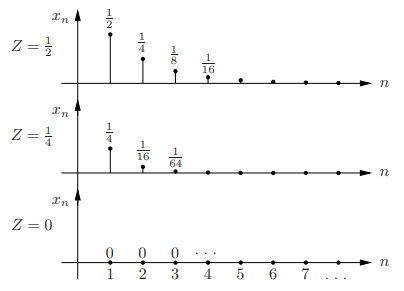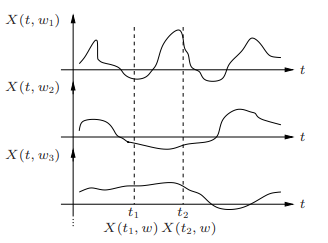 . We know:
. We know:
Now,
So we need
Since, D is the union of the mutually exclusive events
|
If Y is the total number of bit errors in the packet, we have Y=X1+X2+...+Xn. Since Xi∼Bernoulli(p=0.1), we have EXi=μ=p=0.1,Var(Xi)=σ2=p(1−p)=0.09 Using the CLT, we have P(Y>120)=P(Y−nμ/ √nσ>120−nμ/√nσ) =P(Y−nμ/√nσ>120−100/ √90) ≈1−Φ(20/√90)=0.0175 Continuity Correction: Let us assume that Y∼Binomial(n=20,p=12), and suppose that we are interested in P(8≤Y≤10). We know that a Binomial(n=20,p=12) can be written as the sum of n i.i.d. Bernoulli(p) random variables: Y=X1+X2+...+Xn. Since Xi∼Bernoulli(p=12), we have EXi=μ=p=12,Var(Xi)=σ2=p(1−p)=14. Thus, we may want to apply the CLT to write P(8≤Y≤10)=P(8−nμ/√nσ<Y−nμ/√nσ<10−nμ/ √nσ) =P(8−10/√5 <Y−nμ/ √nσ<10−10/ √5)≈Φ(0)−Φ(−2/√5)=0.3145 Since, here, n=20 is relatively small, we can actually find P(8≤Y≤10) accurately. We have P(8≤Y≤10)=
=0.4565
|
P(8≤Y≤10) =P(7.5<Y<10.5) =P(7.5−nμ/√nσ<Y−nμ/√nσ<10.5−nμ/√nσ) =P(7.5−10/√5 <Y−nμ/√nσ<10.5−10/√5) ≈Φ(0.5/√5)−Φ(−2.5/√5) =0.4567
|
|
|
|
The average power P of a signal x(t) over all time is therefore given by the following time average:
|
μY=μX H(0) =0*1= 0 b. To find RY(τ), we first find SY(f) SY(f)=SX(f)|H(f)|2 From Fourier transform tables, we can see that SX(f)=F{e−|τ|}=2/(1+(2πf)2) Then, we can find SY(f) as SY(f)=SX(f)|H(f)|2 =2 |f|<2 = 0 otherwise We can now find RY(τ) by taking the inverse Fourier transform of SY(f) RY(τ)=8 sinc(4τ), where sinc(f)=sin(πf)/πf c. We have E[Y(t)2]=RY(0)=8. |
|
1.Write the random variable of interest, Y, as the sum of n i.i.d. random variable Xi's: Y=X1+X2+...+Xn. 2.Find EY and Var(Y) by noting that EY=nμ,Var(Y)=nσ2, where μ=EXi and σ2=Var(Xi). 3.According to the CLT, conclude that Y−EY/ √Var(Y)=Y−nμ/ √nσ is approximately standard normal; thus, to find P(y1≤Y≤y2), we can write P(y1≤Y≤y2)=P(y1−nμ/√nσ≤Y−nμ/√nσ≤y2−nμ/√nσ) ≈Φ(y2−nμ/ √nσ)−Φ(y1−nμ/√nσ).
|
Here, we state a version of the CLT that applies to i.i.d. random variables. Suppose that X1, X2 , ... , Xn are i.i.d. random variables with expected values EXi=μ<∞ and variance Var(Xi)=σ2<∞. Then the sample mean X¯¯=X1+X2+...+Xnn has mean EX¯=μ and variance Var(X¯)=σ2n.
Where, σ = Population standard deviation μx¯= Sample mean σx¯ = Sample standard deviation n = Sample size
|
The correlation coefficient between X and Y normalizes the covariance such that the resulting statistic lies between -1 and 1. The Pearson correlation coefficient
is
The correlation matrix for X and Y is
|




















